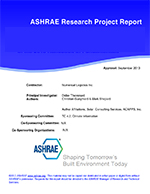Description
Current standards on conditions for human thermal comfort assign relatively low importance to humidity in the comfort zone. However such standards are intended for use only in steady-state conditions. Humidity transients can be expected to have much larger impacts on thermal comfort because of changes in moisture content and associated heats of absorbtion and desorption in the skin and clothing layer. The behaviour of nonhygroscopic polyester and hygroscopic wool clothing ensembles during humidity step-changes and the associated impacts on the dry heat exchanges of the wearer were examined with a thermal manikin. Two adjacent climate chambers, one with 20%, the other with 80% RH, and both with 25°C operative temperature were used for this purpose. Woolen ensembles absorbed or desorbed up to 110 g of moisture two hours after a humidity step, whereas the polyester ensembles absorbed or desorbed less than 6 g under the same conditions. These large changes of woolen fibre regain were associated with sorption heats that significantly changed the dry-heat balance of the thermal manikin by up to 66 kJ/m two hours after the humidity step-change. This heat-loss effect experienced by the manikin represented about 40% of the total sorption heat being evolved/required in the wool clothing. Humidity step-change experiments were also conducted with 12 human subjects going between 20% and 80% RH or vice versa. Weight changes, rectal temperatures, and mean skin temperatures were recorded continuously from two of the subjects, while thermal sensations were monitored continuously from the whole sample. Clothing consisted of two wool and two polyester ensembles, one each at 0.6 and 1.0 clo insulation. Experiments with nude subjects were also conducted as control studies. The thermal sensations of subjects who were either nude or dressed
Product Details
- Published:
- 1988
- Number of Pages:
- 131
- File Size:
- 1 file , 2.7 MB
- Product Code(s):
- D-RP-503




